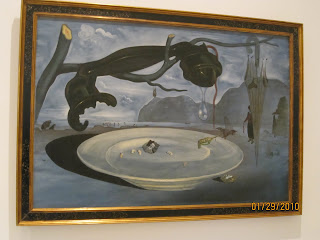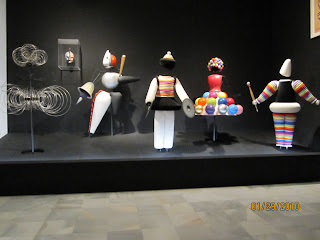This past weekend, February 12th and 13th, was our group trip to Sevilla. Sevilla is located in Andalusia, which is the very south of Spain. Typical weather for Andalusia is extremely warm and sunny; however, Spain is also going through this bizarre weather streak.To our dismay, for the first time in a VERY long time Andalusia was predicted to get snow! Luckily, Sevilla only had rain, but it was still disappointing.
We arrived in Sevilla on Friday only for it to begin pouring on our walk to the hotel. Most of our plans were delayed due to rain, but we did manage to get a tour of the very impressive catedral. The catedral de sevilla is the oldest gothic catedral in Spain and the third oldest in the world. In this catedral is the "tomb" of Christopher Colombus. There are no actual remains found within the tomb, but the structure is very impressive! True to Spanish form, the "casket" is being carried by four men each representing a different region of Spain during the 14th and 15th centuries. Covering the casket is a cloth marked with the symbol of Queen Isabella and King Ferdinand. Their symbol is a yuk (the wooden arches placed over cattle) across numerous arrows.
Saturday the weather was much better! We toured the beautiful Alcazar, a Muslim kingdom that was later taken over by the Catholics in the 13th century. I have TONS of photos so I will limit it to a few. The building itself was very detailed and ornate, but the gardens were what impressed us the most. Behind the royal home are vast gardens as far as the eye can see! It was breathtaking! I can only imagine how beautiful it must be during the warm months when everything is in bloom!
After the Alcazar, we had a few hours of spare time until our return home. Although we were starving for food, we toured the Plaza de Espana first. The grounds were under construction, but the building itself was pretty, especially the individual titled chairs of each major city of Spain.
Following the Plaza we grabbed some quick lunch and slowly made our way back to the hotel, taking in the beauty of Sevilla and all its sidestreets in the sunlight. Even though seeing Sevilla in the rain in February was similar to seeing California under those conditions, I was still able to imagine just how impressive Sevilla must be in perfect weather!
PHOTOS:

Barcelona Chair at Plaza de Espana
My delicious mid-afternoon snack
Tomb of Christopher Colombus
Inside the catedral
Entrance to the catedral
Inside the Alcazar
Wall/Gardens of the Alcazar
Gardens of the Alcazar (these look fake now but I swear they are real)
Beginning inside plaza of Alcazar









































